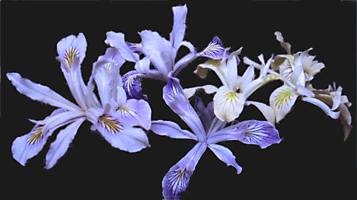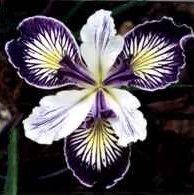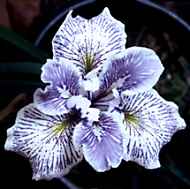Almanac Article
Breeding with Chrysophylla
George Gessert, Eugene, Oregon
Almanac, Fall 2000 Vol 29(2) 6-7
[Adapted and slightly modified for the web; Photos George Gessert]

Hybridizers have given Iris chrysophylla little attention, no doubt because as Pacificas go it is rather modest. The flowers are white or cream-colored with narrow parts held in a single plane like six-pointed stars. They rise only a few inches above the ground. A clump is charming but not comparable to I. tenax, I. douglasiana, I. munzii, I. innominata, or I. bracteata.
Throughout its Oregon range, from the southern Willamette Valley to the California border, Iris chysophylla displays little variation. However, in the Cow Creek drainage in southern Douglas County there are specimens with stems up to twelve inches long, and pink or red bracts.
The "Noti irises" in Lane County have pale lavender flowers. They tend to bloom several weeks earlier than the other Pacificas in the southern Willamette Valley.
Superficially Noti irises look like I. tenax, but their long perianth tubes identify them as I. chrysophylla, or at least as closer to I. chrysophylla than to I. tenax. They are probably an ancient stabilized hybrid population. (See "The Noti Irises of Lane County, Oregon" by Roy Davidson, in the Fall, 1982 Almanac, and "More on the Noti Irises of Lane County, Oregon" also by Roy Davidson, in the Spring, 1987 Almanac.)
No one knows the origin of the Noti irises, but they occur in an area once heavily populated by Kalapooia Indians. Is there a connection between these irises and the Kalapooia? For centuries the Kalapooias set fires to keep land clear for hunting and gathering. The fires burned during the dry season, which usually begins in late June or early July, and runs to the end of September. Dry season fires would have favored irises that bloomed early, and that produced seed capsules close to the ground, where they would have been less vulnerable to flames than capsules held high. The Noti irises have ground-level capsules.
I. tenax X I. chrysophylla hybrid swarms are not uncommon in Lane and Douglas counties. In my experience swarms occur only where human activities have significantly altered the environment, such as along roads, beneath power lines, in pastures, and in clearcuts. In these accidental gardens, irises can be as varied as the hybrids in any breeder's plot. Flowers come in shades of violet, cream, grey, and pink, and often have gold signals webbed with dark veins. Some hybrids bloom earlier or later than either parent species.

The best known I. tenax X I. chrysophylla hybrid is VALLEY BANNER. Its elegantly patterned flower has white standards, dramatic red-purple style arms, and white falls netted with dark purple veins. Ruth Hardy discovered it growing in a field about 20 miles south of Eugene, and registered it in 1958.
During an iris hunt in 1985 I chanced on several other irises with the "Valley Banner" pattern. I described these in "Eight new 'Valley Banners'" in the Fall, 1985 Almanac. Over the next few years I found an additional dozen "Valley Banner"-type irises. I used some of them in breeding, and produced many new "Valley Banner"-type irises.

I. chrysophylla
Second and third generation hybrids included interesting variations on the "Valley Banner" pattern, such as flowers with both standards and falls heavily netted with veins, falls with prominent signals or eyespots, and pale tan "Valley Banners". However, I have not been able to get yellow flowers with a good "Valley Banner"-type pattern. I. chrysophylla's white or cream-colored grounds often reappear in advanced generations. This can be useful in breeding for vein patterns, which show up best on pale grounds.
Besides the "Valley Banner"-type hybrids, I found several other exceptional I. tenax X I. chrysophylla hybrids. One had extremely broad falls, like a round-petalled I. tenax, but was cream-colored and pencilled with a few brown veins in the signals, like I. chrysophylla. Another was an exquisite shade of silvery lilac, a self except for a small violet eyespot at the apex of the signal. Neither of these interspecifics produced noteworthy offspring.

II had better luck with a plant that closely resembled I. chrysophylla, but had white falls covered with pale violet veins that were broken into a uniform pattern of dots and dashes. All offspring from crosses with WESTERN QUEEN and I. innominata had broken vein patterns. The pattern appears to be dominant. However, some hybrids had dots and dashes in many configurations, some of them highly distinctive. Last year I registered a vigorous white iris with intense purple dots and dashes around the signals as RUTH KAC.
I. chrysophylla and its first-generation hybrids almost always have narrow flower parts. However, by crossing these irises with broad-petalled garden hybrids, flower parts as broad as any sold today can be expected in a generation or two. As for I. chrysophylla's short stems, they do not persist when breeding with longer-stemmed Pacificas.
Until very recently I have not had space to grow more than a few dozen hybrid I. chrysophylla per year. There are significant opportunities here for anyone who is patient and curious.